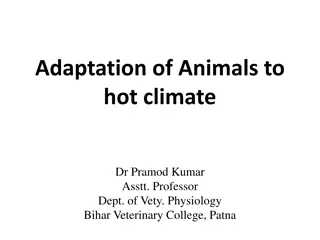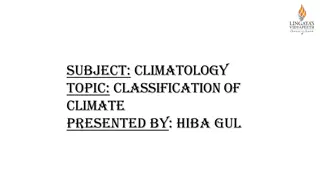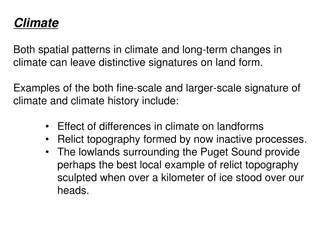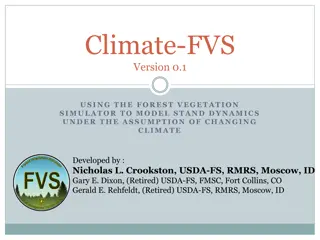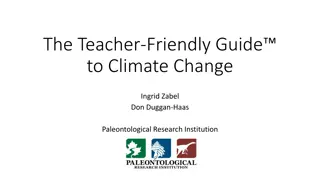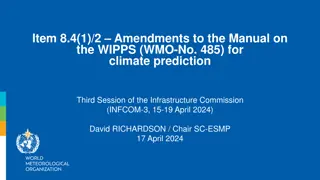Understanding Global Climates and Ireland's Climate
Explore the concept of climate, classification of global climates, and factors influencing Ireland's cool temperate oceanic climate. Learn about different climate types such as hot, temperate, and cold climates, and how Ireland's proximity to seas and oceans affects its weather patterns. Discover the nuances between Irish winters and summers, and the impact of the North Atlantic Current on Ireland's climate.
Download Presentation

Please find below an Image/Link to download the presentation.
The content on the website is provided AS IS for your information and personal use only. It may not be sold, licensed, or shared on other websites without obtaining consent from the author. Download presentation by click this link. If you encounter any issues during the download, it is possible that the publisher has removed the file from their server.
E N D
Presentation Transcript
15 Global Climates Global Climates 15
15 15.0 Global Climates Global Climates Learning Intentions You will be able to: Explain what a climate is. Classify global climates. Understand the factors that affect Ireland s climate.
15 15.1 What is a Climate? Global Climates Climateis the average weather across a large area of the earth s surface. To classify the climate for an area, certain weather conditions, such as level of rainfall or hours of sunshine, must be measured. Conditions are measured for thirty-five years or more before an area s climate is determined. Earth in winter Earth in summer
15 15.2 Classifying Global Climate Types Global Climates Cold Climates Hot Climates Temperate Climates Tundra Equatorial Warm temperate oceanic Boreal Savanna Cool temperate oceanic Hot desert
15 15.2 Classifying Global Climate Types Global Climates Hot Climates Hot climates around the world
15 15.2 Classifying Global Climate Types Global Climates Temperate Climates Temperate climates around the world
15 15.2 Classifying Global Climate Types Global Climates Cold Climates Cold climates around the world
15 15.3 Ireland s Climate Global Climates Ireland has a cool temperate oceanic climate. Irish winters tend to be cool and windy. Irish summers are mostly mild and less windy. Tullagh, Co. Donegal Winter, Co. Donegal Summer, Co. Donegal
15 15.3 Ireland s Climate Global Climates 1. Distance from Seas and Oceans Ireland is an island surrounded by an ocean and a sea. The Atlantic Ocean is the main influence on Ireland s climate. Warm North Atlantic Current (NAC), also known as the North Atlantic Drift.
15 15.3 Ireland s Climate Global Climates 1. Distance from Seas and Oceans Our seas heat up slowly in summer and cool down slowly in winter. Land heats up quickly in summer and cools down quickly in winter. Inland Irish areas have slightly colder winters and slightly warmer summers than Irish coastal areas.
15 15.3 Ireland s Climate Global Climates 2. Latitude The latitude of a place is its distance from the equator. The further a place is from the equator, the cooler it is likely to be.
15 15.3 Ireland s Climate Global Climates 3. Prevailing Winds/Air Masses The wind that blows most regularly over an area is called the prevailing wind or prevailing air mass.
15 15.3 Ireland s Climate Global Climates 4. Altitude and Aspect Smaller areas may experience special climatic conditions of their own. These local climates are influenced by altitude and aspect. Doolough, Co. Mayo
15 15.3 Ireland s Climate Global Climates 4. Altitude and Aspect Altitude means height above sea level. The higher a place is, the colder its climate will be. Temperatures decrease by roughly 1 degree Celsius for every 150 metres climbed. This decrease in temperature is called the lapse rate. Increased (higher) altitude also increases chances of rainfall.
15 15.3 Ireland s Climate Global Climates 4. Altitude and Aspect Aspect is the direction in which a slope faces. In the northern hemisphere, south-facing slopes are warmer than north-facing slopes. Slopes facing the sea experience sea winds and higher levels of rainfall called relief rainfall. Slopes on the leeward sides are drier.
15 Global Climates Video: Climate Change by Numbers Climate Changes










